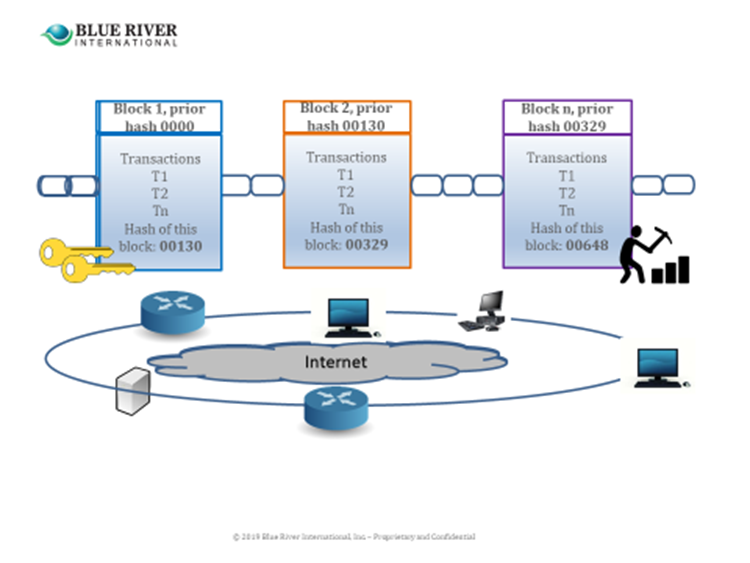Article on Blockchain explained in plain English. It addresses Blockchain interworking at a high level and demystifies known confusion areas like Distributed Ledger Technologies (#DLT) vs. Blockchain.
“All good performance starts with clear goals” – Ken Blanchard.
I was at a Technology Executives conference visiting vendor booths in Denver, Colorado. I stopped by one of the booths and struck a conversation with the Company’s representative.
After discussing his company’s products and services, we started chatting about Blockchain and its potential. “There is still confusion around this technology” he replied, and continued “I flew into Denver from another conference and I witnessed confusion there also.”
The conference ended, but the conversation stayed with me. I was puzzled by his comments. Then I realized that unlike AI or IoT that have been around and understood, Blockchain is a new technology. It is still evolving. And, it can be implemented in several ways, e.g., public or private depending on the objective. All of this can be very confusing to someone not involved with Blockchain.
Brief History
Historically, the Blockchain concept became publicized in 2008 by Satoshi Nakamoto, an individual or a group of individuals using that name. Satoshi Nakamoto vanished soon after the publication. However, the concept took root. Bitcoin cryptocurrency, a Blockchain application, was developed with the first Bitcoin mined in 2009. Bitcoin Blockchain was designed to support Cryptocurrency only.
In 2015, Ethereum, a Blockchain platform, was developed. A Blockchain platform can support multiple purpose-specific Blockchain applications. Ethereum introduced the concept of “smart contracts”.
A smart contract is a self-executing piece of code on a Blockchain. For a given agreement, e.g., between an insured and an insurer, a smart contract encodes both the contract terms and response when the terms encoded on it are met.
When the contract terms are met, e.g., insured filing a valid claim, claim payments are automatically released to the insured. There is no need for intermediaries or manual, labor-intensive claim processing.
Smart contracts benefit from Blockchain characteristics. Some of these include transparency, audit-ability, automation, and immutability. Blockchains are also highly secure.
Blockchain Explained
Blockchain is often confused with Distributed Ledger Technology (DLT) that forms its underpinnings. A DLT is a digital distributed ledger or a database. It allows a participating network of computers, also known as nodes, to simultaneously record transactions as they occur.
DLT is a decentralized system, i.e., there is no central authority that distributes the same ledger copy to all the nodes. Instead, all nodes agree at regular intervals, through a mechanism, that their ledger copies match. Blockchain and DLT are not interchangeable terms. A DLT is not a Blockchain, but a Blockchain is a DLT. Blockchain does away with “Update” and “Delete” functions from CRUD (Create, Read, Update, Delete) operations. So it cannot be labeled as a database.
In a Blockchain, transactions are written in fixed-sized blocks, e.g., 8 MB. Each block is cryptographically hashed. When a block fills up, a new one is opened with the previous block’s hash on it. This links, or chains the new block to the previous one thus forming a Blockchain.
The slide below represents this concept on a public Blockchain where each subsequent block links back to the previous one through its hash. A Blockchain can be public or private, depending on how it is implemented. Most of my article describes the workings of a public Blockchain.
A private Blockchain follows similar principles. Its processing can be much faster, and less secure than a public Blockchain depending on its implementation.

A Blockchain can record any type of transactions. They could be property title, a record of claims paid, digital rights, graduation certificates, digital identities, money transfer records, and others. Every transaction on a Blockchain is time-stamped, chronologically written, and is immutable – i.e., once written, it cannot be changed or deleted.
Participating nodes, as shown above, maintain the Blockchain network. Each node maintains a synchronized copy of all the transactions on it. This is done through a consensus mechanism.
On a public Blockchain, anyone can join or leave anytime. Anyone can read and write transactions to it. A participant gets rewarded for following the public Blockchain’s participation rules.
On a private Blockchain, only those authorized can participate, read, and/or write to it depending on the permissions granted to the authorized users. E.g., a group of companies may choose to create their own private Blockchain defining participation and transactions writing rules.
Blockchain Uses
Blockchain characteristics like immutability, audit-ability, security, automation, trustworthiness, and disintermediation allow for powerful uses cases to be deployed. For this article, I shall continue with the insurance example use case. I would also qualify that my statements below are not absolutes. Use case characteristics can vary based on how a Blockchain is implemented and its operating rules.
An insurer company transacts with many entities daily. Entities may include the insured, service providers, government agencies (data reporting), and others. Transactions between them are verified and recorded.
If problems occur, records have to be audited, sometimes by external auditors. All of this is labor-intensive and costly. Even without a dispute, managing the records between multiple transacting parties is an arduous task.
Since Blockchain records are immutable, audits are easy and cheap. One can always view all the transactions without incurring any additional costs. All parties involved view a single version of the truth. There isn’t a need for labor-intensive and expensive records reconciliation between the parties.
As another example, when asked for identification, we provide much more information than a few attributes necessary to get identified. Blockchain applications allow one to release only attributes relevant to the situation.
For example, if a store requires only a picture id and signature to verify one’s identity, one needs to release only these two attributes. They no longer have to share the entire record like a driver’s license with much more data on it.
Blockchain is equally effective in healthcare, financial services, the insurance industry, supply-chain, cybersecurity, IoT and others. While this technology is still young, its uses are compelling. It has already proven itself in several industries.
Keywords:
#Blockchain #Emergingtech #EnergingTechnologies #ProductManagement #FinancialServices #Insurance #SupplyChain #CEO #CIO #CTO #CPO #Innovation

